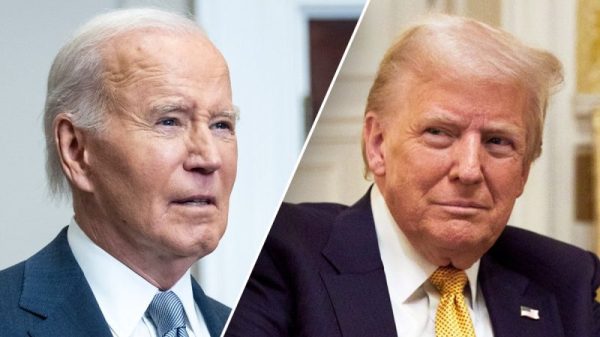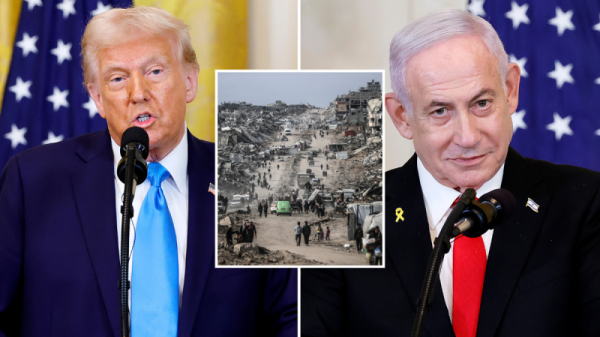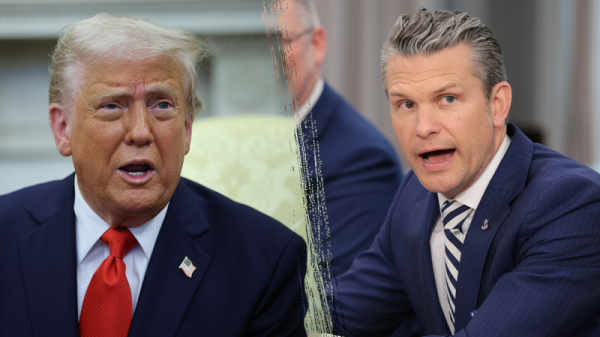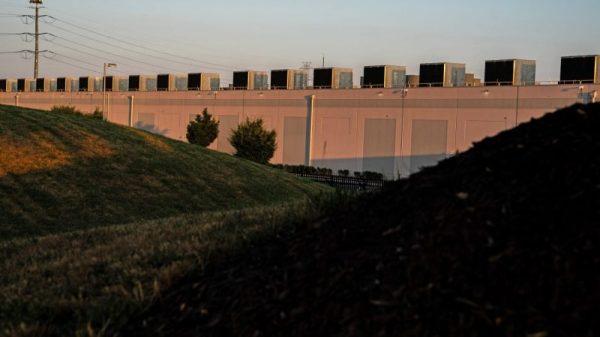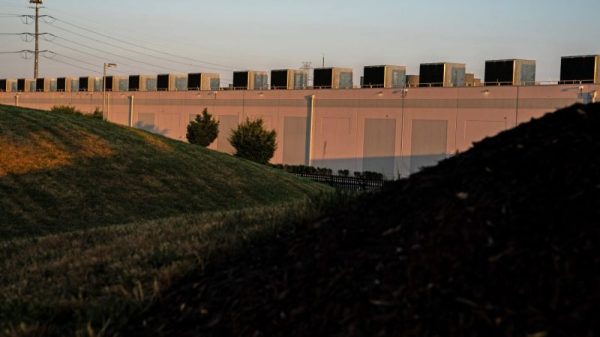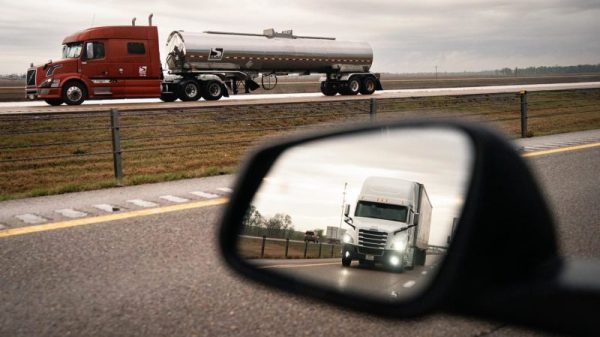Two months into his presidency, Joe Biden confronted a political crisis: The number of migrants illegally crossing the southern border into the United States was soaring. So he asked Vice President Kamala Harris to lead the administration’s diplomatic efforts to reduce problems at the border.
That assignment included working with three Central American countries — El Salvador, Guatemala and Honduras — to improve living conditions and lower the odds that migrants would leave those countries for reasons including poverty, gang violence and corruption.
But Republicans quickly seized on the apparent diplomatic opportunity for Harris, referring to her as the country’s “border czar” responsible for all issues related to the U.S.-Mexico line. Now, more than three years later, her role is a potential political liability as she runs for president as the Democratic nominee and polls show voters broadly disapprove of the Biden administration’s handling of the border.
Harris, in fact, has never been in charge of the border. The Department of Homeland Security manages migration. Her immigration role for the Biden administration has included boosting U.S. aid to Central America, traveling to the region and discouraging potential migrants from making the dangerous journey to the United States.
Migration from the three Central American countries during the Biden administration has fallen 35 percent, from about 683,890 to 447,270 in 2023, lower than it was in 2019 under Trump. But analysts say it is difficult to tie the reduction in numbers to Harris’s efforts, and there have been increases in migration from other countries.
Since launching her presidential campaign, Harris has cast herself as a former prosecutor who took on undocumented gang members, a former border state attorney general in California who prosecuted human traffickers and a would-be president eager to sign into the law the toughest border restrictions in a generation.
Harris told a roaring crowd at a campaign event in Glendale, Ariz., last week that she’d put her record against Republican nominee and former president Donald Trump’s “every day of the week.”
“Donald Trump does not want to fix this problem,” she said. “He talks a big game about border security, but he does not walk the walk.”
Perhaps the most glaring example of the challenges the Biden administration has faced was in December, when nearly 250,000 migrants were apprehended, an all-time high. The numbers went down dramatically this year, largely due to increased enforcement in Mexico, where military patrols and highway checkpoints are intercepting would-be crossers at the U.S. government’s request.
Republicans initially tried to blame Harris for the influx along with Biden, but they intensified their efforts toward her after the president ended his campaign on July 21 amid concerns about his age and Harris declared her candidacy to succeed him.
Biden faced widespread voter disapproval of his handling of the border. A YouGov poll conducted for the Economist this month found that about 60 percent of registered voters disapproved of Biden’s handling of immigration, with 35 percent approving.
The day after Biden dropped out of the race, House Republicans filed a resolution that “strongly condemns the Biden Administration and its Border Czar, Kamala Harris’s, failure to secure the United States border.” A week later, Trump’s campaign released its first advertisement against Harris, assailing her over border security.
“She’s the architect of the border invasion trying to pretend she’s strong on border security,” Trump said at a rally last month in which he repeatedly blamed her for allowing millions of migrants into the country.
Democrats are rebutting GOP attacks more strongly, blaming Trump and his allies for the failure this year of a bipartisan bill that would have invested billions of dollars in border security. After that failed, the Biden administration imposed new asylum restrictions and continued working with Mexico to ramp up enforcement. Apprehensions declined to 56,400 in July, the lowest of any month since September 2020, according to U.S. Customs and Border Protection.
“They’re implementing immigration policy with one hand tied behind their back. Congress has not been helpful at all,” said Kevin Appleby, a senior fellow for policy at the Center for Migration Studies of New York, a think tank. “This is basically the administration doing this all on their own.”
Harris might not deserve personal credit for the drop in border crossings, he said, but she is part of the administration that achieved it. “You can’t blame her for certain administration policies but not give her credit for those that have been successful,” he said.
Biden and Harris had campaigned in 2020 to treat migrants more humanely after years of controversial crackdowns by Trump, whose officials made longtime immigrants targets for deportation and forcibly separated migrant parents and children at the border. The Biden team pledged to pause deportations, process asylum claims and welcome immigrants.
Harris, the daughter of immigrants from Jamaica and India, had a similar platform as a presidential candidate before becoming Biden’s running mate.
She promised to close private immigration detention centers, limit deportations and fight for a path to citizenship for the 11 million undocumented immigrants in the United States.
Those liberal approaches faced swift backlash as migration soared after Biden took office. Analysts say the Biden administration was slow to respond to triggers of mass migration, including pandemic-shredded economies, a robust U.S. job market and the perception that Biden would be more lenient than Trump.
Biden warned before taking office that he did not want 2 million people on the border, and he kept in place a Trump policy that allowed border agents to rapidly expel migrants until May 2023. But Biden also relaxed enforcement, and just as he feared, apprehensions soared to an average of 2 million a year, the highest ever recorded.
Record numbers of unaccompanied children from Central America arrived at the border, some taking dangerous jobs meant for adults. Texas’s Republican governor began busing thousands of migrants from the border to New York, Chicago and other Democrat-led cities, overwhelming their shelters and straining their budgets.
In February 2021, Biden issued an executive order pledging to address the root causes driving migration from northern Central America, which then accounted for about half of border apprehensions. The next month he asked Harris to lead the effort, noting that he had played a similar role as vice president to former president Barack Obama.
Republicans pounced, identifying Harris with rising illegal crossings and calling on the vice president to visit the border.
Harris’s allies recognized the issue as politically fraught, one that could hinder her eventual campaign to succeed Biden. U.S. presidents have struggled for decades to address immigration, with little help from an increasingly polarized Congress. Harris quickly carved out a more limited role, one that focused on the Central American countries and not on the southern border.
In June 2021, Harris made her first and only trip to the border, a 4½-hour visit touring operations in El Paso, hundreds of miles away from the busiest spot on the border. Earlier that month she also visited Mexico and Guatemala, a country Biden went to in 2014.
Like Biden, Harris urged would-be migrants in Guatemala to stay home and warned them that they could be deported.
“Do not come,” she said then. “You will be turned back.”
Her words stunned advocates for immigrants, but some in the Biden administration were increasingly alarmed about the border.
The rising numbers were a sign that Obama-era efforts to address root causes had not taken hold and were not so easy to solve in an election cycle. When Biden visited Guatemala in June 2014, Border Patrol apprehensions that month totaled 57,860. When Harris visited in the same month seven years later, apprehensions were 178,650.
The Trump administration interrupted Obama-era diplomacy to prevent migration, analysts say. Trump slashed aid to Central America, decimated refugee programs and denigrated other countries.
“We were left with a mess,” said Katie Tobin, a former Biden immigration adviser.
Advocates for immigrants said that Trump’s approach did not stop mass migration either. In 2019, attempted border crossings surpassed 850,000. The pandemic interrupted that trend in 2020 by stalling global travel and enabling Trump to expel migrants without a hearing, cutting attempted crossings in half.
It remains unclear if Trump could replicate that strategy, if elected, since the U.S. economy also rebounded more strongly than that of other countries, creating a powerful jobs magnet.
Harris focused mainly on private and public investment in Central America.
Her effort included dispatching coronavirus vaccines there, creating anti-smuggling task forces and investing $4 billion in U.S. aid to the region, but she faced challenges because Central America was riven by gangs and corrupt leaders after years of failed U.S. intervention.
“She didn’t exactly have the easiest partners,” said Roberta Jacobson, former U.S. ambassador to Mexico who served as the top White House official on the border during the early months of Biden’s administration.
Aides say Harris’s most powerful influence was in the private sector, helping to create jobs so that people would stay home.
In May 2021, she issued a “call to action” to tackle the root causes of migration from northern Central America. She met with a dozen CEOs at the White House to encourage investment in the region to create jobs and improve supply chains by moving overseas operations closer to the United States. They began with $750 million in investments, loans, housing and other resources.
Since then, more than 50 companies have gotten involved, and total investment has surpassed $5.2 billion and created more than 70,000 jobs in the region, said Jonathan Fantini-Porter, the CEO of the Partnership for Central America, the nonprofit that oversees the implementation of the effort.
Columbia Sportswear, Nespresso and auto-parts manufacturer Yazaki North America Inc., and others created thousands of manufacturing and farming jobs in the region.
Ariel Ruiz Soto, senior policy analyst at the Migration Policy Institute, said the reasons for the decline in Central America vary by country. Gang crackdowns in El Salvador, a new leader in Honduras, and increased enforcement in Guatemala and Mexico may have played a role.
“There is no direct correlation to say that the root causes strategy has led to this decrease,” Ruiz Soto said. “The reality is there hasn’t been a steady evaluation over time of these executive policies.”
“This would not be a root causes thing. There is no way that in two years it makes a difference,” said Mark Krikorian, executive director of the Center for Immigration Studies, a think tank that supports reduced immigration levels.
More likely is the intense enforcement in Mexico and increased removals from the United States are having an effect, analysts say.
Another challenge for Harris is that northern Central Americans are no longer the biggest group arriving at the border. They accounted for 71 percent of all border crossers in 2019, but so far this year are 23 percent since the number of people from China, Venezuela and other nontraditional nations has increased.
Harris has said that she would continue the Biden administration’s hard line approach to the border if she wins the presidency. She supported the bipartisan border security bill Biden backed this year, which included measures that would have effectively shut down the border if illegal crossings surpassed 5,000 a day. She has pledged to sign the bill as president.
Harris’s campaign leaned into the border messaging with a recent television ad that highlighted her support for the “toughest border control bill in decades” and her history prosecuting drug smugglers.
“As president, she will hire thousands more border agents and crack down on fentanyl and human trafficking,” the narrator said in the ad. “Fixing the border is tough. So is Kamala Harris.”

